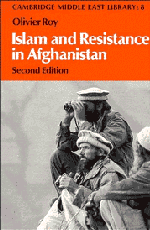Book contents
- Frontmatter
- Contents
- Acknowledgements
- Maps
- Introduction
- 1 State and society in Afghanistan
- 2 Islam in Afghanistan
- 3 The origins of Afghan fundamentalism and popular movements up to 1947
- 4 The Islamist movement up to 1978
- 5 The communist reforms and the repression, 1978–9
- 6 The uprisings, 1978–9
- 7 The establishments of political parties
- 8 The development of the parties between 1980 and 1984
- 9 The role of the Shiʿa in the resistance
- 10 Society and the war
- 11 From freedom fighter to guerilla
- 12 Military operations
- 13 The conflict from 1986 to the Soviet withdrawal
- 14 Cultural patterns and changes in society: an assessment
- 15 Afghan politics and the outside world
- Appendixes
- Notes
- Bibliography
- Index
14 - Cultural patterns and changes in society: an assessment
- Frontmatter
- Contents
- Acknowledgements
- Maps
- Introduction
- 1 State and society in Afghanistan
- 2 Islam in Afghanistan
- 3 The origins of Afghan fundamentalism and popular movements up to 1947
- 4 The Islamist movement up to 1978
- 5 The communist reforms and the repression, 1978–9
- 6 The uprisings, 1978–9
- 7 The establishments of political parties
- 8 The development of the parties between 1980 and 1984
- 9 The role of the Shiʿa in the resistance
- 10 Society and the war
- 11 From freedom fighter to guerilla
- 12 Military operations
- 13 The conflict from 1986 to the Soviet withdrawal
- 14 Cultural patterns and changes in society: an assessment
- 15 Afghan politics and the outside world
- Appendixes
- Notes
- Bibliography
- Index
Summary
The central issue we have addressed in this book has been the aptitude of the Islamist movement to carry out a modernisation of society. After ten years of war, we can assess to what extent, if at all, new political structures have been able to bypass traditional segmentation, and whether Islamic law might have provided an alternative to both tribal common law and a pervasive endemic violence. The final picture is contrasted, but suggests a global failure with some local breakthroughs. But the war has definitely altered the traditional fabric of the Afghan society.
The re-traditionalisation of the new political structures and leadership
The sudden withdrawal of the Soviets, as well as of the government troops in many areas, deprived the Mujahidin of both a common enemy and of a raison d'étre. As we have seen the strategy of a qawm is to enhance its local power and to fight state encroachments. When the state withdraws, as has been largely the case in 1988, the main danger comes from the next qawm, even if the antagonism is expressed in political terms.
In fact, the Mujahidin have never been able to replace a traditional structure by a modern political one. The “de-ideologisation” of the Afghan war that followed the Soviet withdrawal entailed a process of “retraditionalisation” of the Afghan resistance. The situation in Afghanistan is not, on both sides, a mere return to tradition.
- Type
- Chapter
- Information
- Islam and Resistance in Afghanistan , pp. 215 - 227Publisher: Cambridge University PressPrint publication year: 1990



